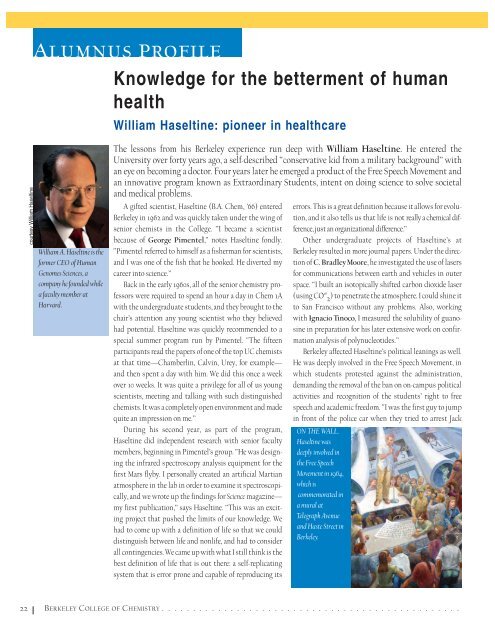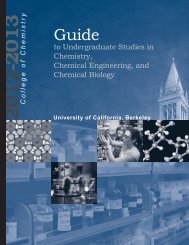Newsjournal body.qxp - College of Chemistry - University of ...
Newsjournal body.qxp - College of Chemistry - University of ...
Newsjournal body.qxp - College of Chemistry - University of ...
Create successful ePaper yourself
Turn your PDF publications into a flip-book with our unique Google optimized e-Paper software.
courtesy William Haseltine<br />
Alumnus Pr<strong>of</strong>ile<br />
Knowledge for the betterment <strong>of</strong> human<br />
health<br />
William A. Haseltine is the<br />
former CEO <strong>of</strong> Human<br />
Genomes Sciences, a<br />
company he founded while<br />
a faculty member at<br />
Harvard.<br />
William Haseltine: pioneer in healthcare<br />
The lessons from his Berkeley experience run deep with William Haseltine. He entered the<br />
<strong>University</strong> over forty years ago, a self-described “conservative kid from a military background” with<br />
an eye on becoming a doctor. Four years later he emerged a product <strong>of</strong> the Free Speech Movement and<br />
an innovative program known as Extraordinary Students, intent on doing science to solve societal<br />
and medical problems.<br />
A gifted scientist, Haseltine (B.A. Chem, ’66) entered<br />
Berkeley in 1962 and was quickly taken under the wing <strong>of</strong><br />
senior chemists in the <strong>College</strong>. “I became a scientist<br />
because <strong>of</strong> George Pimentel,” notes Haseltine fondly.<br />
“Pimentel referred to himself as a fisherman for scientists,<br />
and I was one <strong>of</strong> the fish that he hooked. He diverted my<br />
career into science.”<br />
Back in the early 1960s, all <strong>of</strong> the senior chemistry pr<strong>of</strong>essors<br />
were required to spend an hour a day in Chem 1A<br />
with the undergraduate students, and they brought to the<br />
chair’s attention any young scientist who they believed<br />
had potential. Haseltine was quickly recommended to a<br />
special summer program run by Pimentel. “The fifteen<br />
participants read the papers <strong>of</strong> one <strong>of</strong> the top UC chemists<br />
at that time—Chamberlin, Calvin, Urey, for example—<br />
and then spent a day with him. We did this once a week<br />
over 10 weeks. It was quite a privilege for all <strong>of</strong> us young<br />
scientists, meeting and talking with such distinguished<br />
chemists. It was a completely open environment and made<br />
quite an impression on me.”<br />
During his second year, as part <strong>of</strong> the program,<br />
Haseltine did independent research with senior faculty<br />
members, beginning in Pimentel’s group. “He was designing<br />
the infrared spectroscopy analysis equipment for the<br />
first Mars flyby. I personally created an artificial Martian<br />
atmosphere in the lab in order to examine it spectroscopically,<br />
and we wrote up the findings for Science magazine—<br />
my first publication,” says Haseltine. “This was an exciting<br />
project that pushed the limits <strong>of</strong> our knowledge. We<br />
had to come up with a definition <strong>of</strong> life so that we could<br />
distinguish between life and nonlife, and had to consider<br />
all contingencies. We came up with what I still think is the<br />
best definition <strong>of</strong> life that is out there: a self-replicating<br />
system that is error prone and capable <strong>of</strong> reproducing its<br />
errors. This is a great definition because it allows for evolution,<br />
and it also tells us that life is not really a chemical difference,<br />
just an organizational difference.”<br />
Other undergraduate projects <strong>of</strong> Haseltine’s at<br />
Berkeley resulted in more journal papers. Under the direction<br />
<strong>of</strong> C. Bradley Moore, he investigated the use <strong>of</strong> lasers<br />
for communications between earth and vehicles in outer<br />
space. “I built an isotopically shifted carbon dioxide laser<br />
(using CO18 2 ) to penetrate the atmosphere. I could shine it<br />
to San Francisco without any problems. Also, working<br />
with Ignacio Tinoco, I measured the solubility <strong>of</strong> guanosine<br />
in preparation for his later extensive work on confirmation<br />
analysis <strong>of</strong> polynucleotides.”<br />
Berkeley affected Haseltine’s political leanings as well.<br />
He was deeply involved in the Free Speech Movement, in<br />
which students protested against the administration,<br />
demanding the removal <strong>of</strong> the ban on on-campus political<br />
activities and recognition <strong>of</strong> the students’ right to free<br />
speech and academic freedom. “I was the first guy to jump<br />
in front <strong>of</strong> the police car when they tried to arrest Jack<br />
ON THE WALL.<br />
Haseltine was<br />
deeply involved in<br />
the Free Speech<br />
Movement in 1964,<br />
which is<br />
commemorated in<br />
a mural at<br />
Telegraph Avenue<br />
and Haste Street in<br />
Berkeley.<br />
22 BERKELEY COLLEGE OF CHEMISTRY . . . . . . . . . . . . . . . . . . . . . . . . . . . . . . . . . . . . . . . . . . . . . . . .




